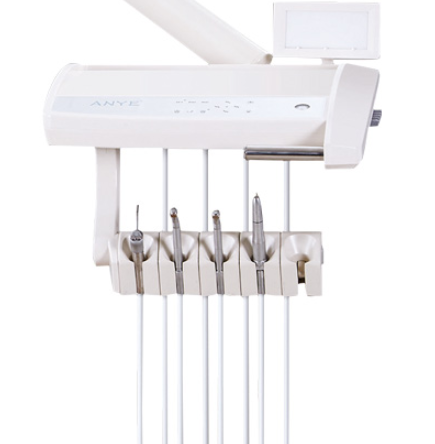Everything about Dental Chair Handpiece Holders
In the bustling environment of a dental practice, the efficiency and organization of equipment play a pivotal role. Among these tools, the dental chair handpiece holder stands as a crucial component, ensuring accessibility and functionality during procedures.
Selecting the right holder is a decision that impacts workflow, hygiene, and overall patient care. However, how can I find the right dental handpiece holder? Fortunately, you can have a full guide to find the right handpiece holder.
Selecting the right holder is a decision that impacts workflow, hygiene, and overall patient care. However, how can I find the right dental handpiece holder? Fortunately, you can have a full guide to find the right handpiece holder.
What are the Types of Dental Chair Handpiece Holders?
To meet various dental treatment purposes, dental chair handpiece holders come with various types, including wall-mounted holders, cart-mounted holders and chair-mounted holders.
●Wall-mounted holders offer stability and space efficiency. They are fixed to the wall within easy reach, providing a secure place for handpieces. However, they might limit flexibility in positioning.
●Cart-mounted holders are mobile and adaptable. They offer the advantage of maneuverability but might occupy space and require occasional repositioning.
●Chair-mounted holders are attached directly to the dental chair, ensuring proximity to the practitioner. They offer convenience but may vary in compatibility with different chair models.
●Wall-mounted holders offer stability and space efficiency. They are fixed to the wall within easy reach, providing a secure place for handpieces. However, they might limit flexibility in positioning.
●Cart-mounted holders are mobile and adaptable. They offer the advantage of maneuverability but might occupy space and require occasional repositioning.
●Chair-mounted holders are attached directly to the dental chair, ensuring proximity to the practitioner. They offer convenience but may vary in compatibility with different chair models.
Factors for Consideration
When you looking through the whole dental equipment market, you need to take the following factors into the selection of the dental chair handpiece holder
Compatibility with Handpieces
Consider the diversity of handpieces your practice utilizes. Some holders may accommodate a specific type or size, while others offer more versatility. Ensure the holder can securely house the range and quantity of handpieces regularly employed in your clinical procedures. This includes considering both high and low-speed handpieces, air-driven or electric options, and specialty instruments like endodontic or surgical handpieces.
Ergonomics and Adjustability
Flexibility is key to accommodate varying procedural requirements and user comfort. Look for holders that allow rotation, height adjustment, and angle customization. An ergonomic design not only enhances efficiency during treatments but also reduces strain on the practitioner, promoting a more comfortable working environment.
Durability and Materials
Given the rigorous nature of dental practices, durability is crucial. Opt for materials that withstand constant use, sterilization processes, and chemical cleaning agents without compromising integrity. Stainless steel, aluminum, or high-quality plastics are often preferred for their resilience and ease of maintenance.
Installation and Integration
Effortless integration into your existing dental chair setup minimizes disruptions to your workflow. Ensure compatibility with your chair's design and mounting options. Easy installation reduces downtime and avoids the need for extensive adjustments or additional accessories.
Key Features to Look For
You also need to pay attention to the key features of the dental chair handpiece holder.
Secure Grip Mechanism
A robust grip mechanism is paramount. It should securely hold handpieces in place to prevent accidental falls or slips during procedures. Look for holders with adjustable clamps or locking mechanisms that ensure a snug fit for various handpiece sizes without compromising accessibility.
Hygiene and Infection Control
Maintaining a sterile environment is critical. Seek holders with smooth surfaces and removable components that facilitate thorough cleaning and disinfection protocols. Consider designs that minimize contact points, reducing the risk of cross-contamination between patients.
Noise and Vibration Reduction
Enhanced patient comfort can be achieved by selecting holders designed to minimize noise and vibration during operation. Look for features such as dampening materials or cushioning mechanisms that absorb vibrations, reducing both auditory discomfort and physical sensations for the patient.
Conclusion
Selecting the ideal dental chair handpiece holder requires a balanced consideration of functionality, hygiene, and compatibility. Investing in a dental chair handpiece holder that addresses these factors and key features can significantly contribute to the efficiency, comfort, and hygiene standards of your dental practice.



Leave a comment